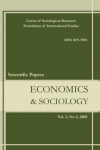HAPPINESS AND HAPPINESS
INEQUALITY IN AZERBAIJAN:
RESULTS WITH SINGLE-ITEM AND
MULTIPLE-ITEM CONSTRUCTS
HAPPINESS AND HAPPINESS
INEQUALITY IN AZERBAIJAN:
RESULTS WITH SINGLE-ITEM AND
MULTIPLE-ITEM CONSTRUCTS
Author(s): Khatai AliyevSubject(s): Methodology and research technology, Applied Sociology, Evaluation research, Socio-Economic Research
Published by: Fundacja Centrum Badań Socjologicznych
Keywords: happiness; happiness inequality; life satisfaction; single- item construct; multiple-item construct; public policy;
Summary/Abstract: This paper compares the performance of thesingle-item (a 1-10 scale) and multiple-item constructs(Satisfaction With Life Scale (SWLS), 5-item and 7-itemlife domain scales) employed to measure happiness andhappiness inequality based on the same survey data. Usinga cross-sectional dataset of 2208 respondents fromAzerbaijan, the study examines the reliability and validityof each scale. Further, it discusses the scales’ predictedhappiness and happiness inequality indicators within theaggregate sample and sub-samples of specific socio-demographic groups. The research results confirm thereliability and validity of multiple-item constructs. In fact,there is a strong positive correlation between all theexamined constructs of happiness. Interestingly, the meanhappiness predicted by the single-item, SWLS, 5-item,and 7-item life domain scales does not vary much. Themean happiness percentage of the highest score in eachconstruct varies within [50.8%; 62.1%] for the aggregatesample. SWLS’s happiness prediction is lower than thatof others by 7-11 percentage points, followed by the 5-item life domain scale and the single-item scale. Thehappiness prediction difference between the single-itemconstruct and the 7-item life domain scale is negligible. Interms of predicting happiness inequality, the 7-item lifedomain scale displays the least dispersion as per bothstandard deviation and coefficient of variation indicators.Conversely, the single-item construct yields the largestvariability. Research findings are consistent regardless ofage groups, gender identity, educational attainment level,marital status, employment status, and residential area.The overall recommendation is to use a multiple-item lifedomains scale to measure happiness and happinessinequality in a society, as it offers a broader perspectivefor using happiness research findings in improving publicpolicy efficiency.
Journal: Economics and Sociology
- Issue Year: 16/2023
- Issue No: 4
- Page Range: 244-263
- Page Count: 20
- Language: English

